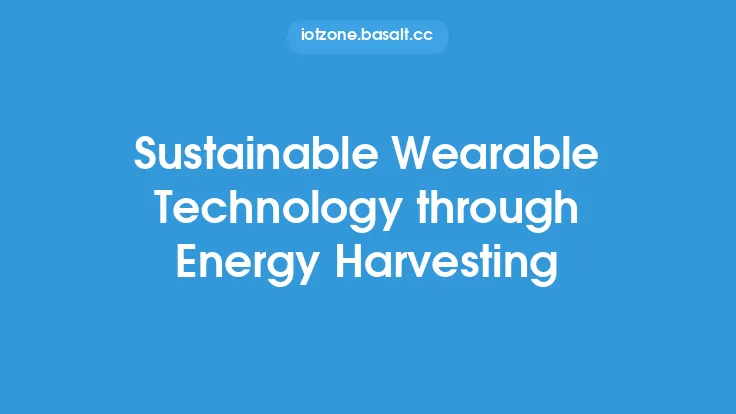The concept of wearable energy harvesting has been gaining significant attention in recent years, and for good reason. As the demand for wearable technology continues to grow, the need for sustainable and efficient power sources has become increasingly important. Wearable devices, such as smartwatches, fitness trackers, and health monitors, have become an integral part of our daily lives, providing us with valuable insights into our physical and mental well-being. However, these devices are often limited by their battery life, which can be a major constraint for users who rely on them for extended periods.
Introduction to Wearable Energy Harvesting
Wearable energy harvesting refers to the process of capturing and converting ambient energy into electrical energy, which can be used to power wearable devices. This technology has the potential to revolutionize the way we power our wearable devices, enabling them to run indefinitely without the need for batteries or recharging. There are several types of energy harvesting technologies that can be used for wearable devices, including solar, thermal, kinetic, and electromagnetic energy harvesting.
Types of Wearable Energy Harvesting Technologies
Solar energy harvesting is one of the most common types of energy harvesting technologies used for wearable devices. This technology involves the use of photovoltaic cells to convert sunlight into electrical energy. Solar energy harvesting is particularly useful for wearable devices that are exposed to sunlight for extended periods, such as smartwatches or fitness trackers. However, the amount of energy that can be generated through solar energy harvesting is limited by the amount of sunlight that the device is exposed to, which can be a constraint in low-light environments.
Thermal energy harvesting, on the other hand, involves the use of thermoelectric materials to convert heat into electrical energy. This technology is particularly useful for wearable devices that are in close proximity to the human body, such as smart clothing or health monitors. Thermal energy harvesting can generate a significant amount of energy, particularly in applications where the device is exposed to high temperatures.
Kinetic energy harvesting involves the use of piezoelectric materials to convert mechanical energy into electrical energy. This technology is particularly useful for wearable devices that are subject to mechanical stress or vibration, such as fitness trackers or smart shoes. Kinetic energy harvesting can generate a significant amount of energy, particularly in applications where the device is exposed to high levels of mechanical stress.
Electromagnetic energy harvesting, on the other hand, involves the use of antennas or coils to capture electromagnetic radiation and convert it into electrical energy. This technology is particularly useful for wearable devices that are exposed to electromagnetic fields, such as smartwatches or fitness trackers. Electromagnetic energy harvesting can generate a significant amount of energy, particularly in applications where the device is exposed to high levels of electromagnetic radiation.
Wearable Energy Harvesting Systems
A wearable energy harvesting system typically consists of several components, including an energy harvesting device, a power management system, and a storage device. The energy harvesting device is responsible for capturing and converting ambient energy into electrical energy. The power management system is responsible for regulating the flow of energy and ensuring that the device is powered efficiently. The storage device is responsible for storing excess energy that is not immediately used by the device.
The design of a wearable energy harvesting system depends on the specific application and the type of energy harvesting technology used. For example, a solar energy harvesting system may require a large surface area to capture sunlight, while a thermal energy harvesting system may require a high degree of thermal conductivity to convert heat into electrical energy.
Materials and Manufacturing Techniques
The materials and manufacturing techniques used for wearable energy harvesting devices are critical to their performance and efficiency. For example, the use of flexible materials such as polymers or textiles can enable the creation of wearable devices that are comfortable and conformable to the human body. The use of nanostructured materials such as nanowires or nanoparticles can also enhance the efficiency of energy harvesting devices.
The manufacturing techniques used for wearable energy harvesting devices can also have a significant impact on their performance and efficiency. For example, the use of 3D printing or inkjet printing can enable the creation of complex geometries and structures that can enhance the efficiency of energy harvesting devices. The use of roll-to-roll processing or screen printing can also enable the high-volume production of wearable energy harvesting devices.
Challenges and Limitations
Despite the potential of wearable energy harvesting, there are several challenges and limitations that must be addressed. One of the major challenges is the limited amount of energy that can be generated through wearable energy harvesting, which can be a constraint for devices that require high levels of power. Another challenge is the variability of ambient energy sources, which can make it difficult to predict and optimize energy harvesting performance.
The cost and complexity of wearable energy harvesting devices can also be a significant challenge, particularly for high-volume production. The use of exotic materials or complex manufacturing techniques can drive up the cost of wearable energy harvesting devices, making them less competitive with traditional battery-powered devices.
Applications and Future Directions
The applications of wearable energy harvesting are diverse and widespread, ranging from consumer electronics to medical devices. For example, wearable energy harvesting can be used to power smartwatches or fitness trackers, enabling them to run indefinitely without the need for batteries or recharging. Wearable energy harvesting can also be used to power medical devices such as pacemakers or implantable cardioverter-defibrillators, enabling them to run for extended periods without the need for surgery or replacement.
The future of wearable energy harvesting is exciting and promising, with several emerging trends and technologies that are expected to drive growth and innovation. For example, the use of artificial intelligence and machine learning can enable the optimization of energy harvesting performance and the prediction of energy demand. The use of advanced materials and manufacturing techniques can also enable the creation of wearable energy harvesting devices that are more efficient, flexible, and conformable to the human body.
Conclusion
In conclusion, wearable energy harvesting is a key technology that has the potential to revolutionize the way we power our wearable devices. The use of solar, thermal, kinetic, and electromagnetic energy harvesting technologies can enable the creation of wearable devices that are sustainable, efficient, and autonomous. While there are several challenges and limitations that must be addressed, the applications and future directions of wearable energy harvesting are diverse and promising. As the demand for wearable technology continues to grow, the need for sustainable and efficient power sources will become increasingly important, making wearable energy harvesting a critical technology for the future.





